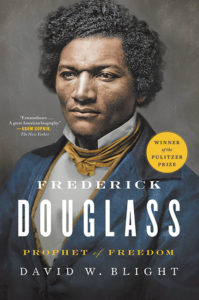Frederick Douglass: Prophet of Freedom
Reviewed by Jerry Mizell Williams.
April 1, 2020
 By David W. Blight. Simon & Schuster, 2018. 912 pages. $37.50/hardcover; $22/paperback; $14.99/eBook.
By David W. Blight. Simon & Schuster, 2018. 912 pages. $37.50/hardcover; $22/paperback; $14.99/eBook.
David Blight’s earlier publications about Frederick Douglass have paved the way for this epic biography based on new documents from the Walter O. Evans collection of invaluable materials about the last third of Douglass’s life. To prove Douglass worthy of the title of prophet, Blight mines the Evans collection, interrogates Douglass’s grounding in and use of the Old Testament, and reinterprets his subject’s three autobiographies: Narrative of the Life of Frederick Douglass, an American Slave (1845), My Bondage and My Freedom (1855), and the post-Civil War Life and Times of Frederick Douglass (1881).
The biography, insists Blight, is that of a prophetic “voice and pen.” Blight reconstructs and elucidates Douglass’s middle years from “a radical outsider . . . to a political insider.” In a conventional approach that characterizes many biographies of African Americans, where experience is spoken of in terms of color, Blight first humanizes then lionizes his subject. There is unresolved tension between Douglass the self-made man and the self-made hero, “an icon held in some degree of commonality.” Ever conscious of his image, Douglass holds the record during the nineteenth century for the most photographed American.
When Douglass purchased his freedom in 1846, he came to better understand the economic and political brutality of the plantation South and the heavy psychological burden borne by slaves in a society hostile to their existence. Believing in a Christian God, he joined forces with abolitionists and campaigned for emancipation, ultimately estranging himself from the likes of William Lloyd Garrison with his brand of nonresistance and moral suasion.
Instead, Douglass proposed death to slave catchers and slaveholders as part of his “strident advocacy of violent resistance against the terror practiced against fugitive slaves.” In the early years, disenfranchised of the civil rights of citizenship, he resorted to moral persuasion. Douglass’s moral authority emanated from his lived experience, bolstered by his intelligence and oratory. An astute politician who navigated partisan waters, he found within the Republican Party supporters capable of furthering his agenda. Douglass was successful at building coalitions, friendships, and collaborations at home and abroad. Chapter 15, “John Brown Could Die for the Slave,” lends insight into how a relationship with Brown led Douglass to search for logic in violence in the face of Dred Scott and the Fugitive Slave Act.
While Douglass’s political history, travels, and activism are well-chronicled, it is in his private life that lacunae or gaps exist. Douglass’s writings admit little about his domestic situation, namely the relationship with wife, Anna Murray. The paucity of information about Anna owes less to conventions of nineteenth-century matrimonial propriety than to Douglass’s universe, where he occupied center stage.
It was Anna, aided by other freed Blacks, who sold her feather bed to finance Douglass’s escape from slave master Hugh Auld in September 1838. (Blight overlooks the opportunity to cite her as Douglass’s first underground railroad conductor.) Anna is the sine qua non of Douglass’s ascent, an integral figure overshadowed by her spouse and the other women in his sphere. Seen as a liability, she is misrepresented as a wife with no moral authority on which to build a narrative. Her marriage was strained by being forced to share her home with two White women benefactors: German abolitionist and writer Ottilie Assing and British abolitionist Julia Griffiths. Their separate correspondence about time spent in the Douglass household is revealing.
Not only was Anna illiterate and a rival for Douglass’s attention, but many also regarded her as incapable of offering her husband the intellectual stimulation and professional assistance he needed. Blight delineates what he sees in Anna as a legitimate wife, assaying her within the context of her merits. Anna carried on with the five children and other resident family members despite Douglass’s prolonged absences and debilitating obsession with being financially secure. Historians have long pondered why Douglass did not separate from or divorce Anna Murray, an act that would have had him perpetrate on his biological family the very pain of separation and division he had experienced, and which continued to define his story. After Anna’s death, he secretly wed his former copyist, Helen Pitts, a White woman.
Complex and layered, this macroscopic biography does not disappoint, despite missing information about sociopolitical interactions with Harriet Tubman and poet and abolitionist Frances Ellen Watkins Harper, among others, that influenced Douglass’s character. Blight’s analysis of the 1854 speech “What to the Slave Is the Fourth of July?” is skillful, as is the side-by-side dissection of Narrative and My Bondage and My Freedom. Quaker readers looking for corroboration of Douglass’s interface with the Religious Society of Friends (not mentioned by name) will find passing references, with the spotlight on selected individuals. Douglass gave his last public lecture on February 1, 1895, on “The Race Problem.” Although he averred that “I am now too old to play orator,” within the statesman, philosopher, journalist, politician, abolitionist, Constitution inquisitor, father, and husband, the dignified lion still roared and the prophet stirred divine.


